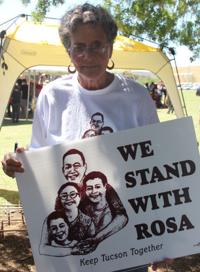To the “great consternation” of a Pima County Superior Court judge, federal immigration agents arrested a Mexican man at the county courthouse before he could be sentenced for a minor drug crime.
The arrest by U.S. Immigration and Customs Enforcement agents is part of a “sea change” in how agents operate in the courthouse since the presidential election, public defender Margo Cowan said.
The Feb. 24 arrest of Jose Salome Zazueta Medina was “not acceptable,” Cowan said, because it “interrupted the judicial process.”
But ICE said in a statement it has not changed how it makes arrests at the Pima County Courthouse, which the agency has done for years. Instead, what has changed is the news media’s scrutiny of those arrests in recent months.
Arrests by ICE agents at courthouses in Texas, Oregon and California have prompted headlines since January.
Judge Michael Butler said at a March 10 hearing he is “ready to hear what the story is” from ICE. So far, Butler said ICE’s story is that agents arrested Zazueta Medina because he exited the courthouse elevators and they thought he was trying to flee.
The arrest caused Zazueta Medina, who is being held at a federal detention center in Eloy, to miss a sentencing hearing the day of his arrest by ICE and another sentencing hearing March 10.
ICE did not inform Cowan that her client was going to be arrested, she said. Under the previous administration, that action would have been taken after a “completely civil discussion” with ICE agents.
Katie Daubert works with Cowan on a team of public defenders that handles local cases of noncitizens charged with serious crimes.
Daubert said ICE agents wait for her clients to plead guilty and then take them into custody, which is “something that didn’t happen a few months ago.”
Cowan stressed courthouses must remain “safe spaces” for people who are in the country without legal status, especially those who are witnesses or victims of crimes.
ICE agents frequently make arrests in the county courthouse, but it was unusual that agents made an arrest prior to a sentencing hearing, said Deputy County Attorney Kellie Johnson, who responded to questions from the Star but did not handle Zazueta Medina’s case.
The County Attorney’s Office is working with ICE to make sure Zazueta Medina attends his sentencing hearing, Johnson said.
Zazueta Medina’s third sentencing hearing is scheduled for April 7.
Deportation officers with ICE’s Enforcement and Removal Operations arrested Zazueta Medina at the courthouse after he pleaded guilty to a felony, ICE spokeswoman Yasmeen Pitts O’Keefe said in an emailed response to questions from the Star. He will remain in ICE custody until an immigration judge reviews his removal case.
In general, decisions about where and how to make arrests are based on the arrestee’s criminal history, safety considerations and “any sensitivities involving the arrest location,” Pitts-O’Keefe said.
Many of the people ICE arrests at courthouses are foreign nationals with prior criminal convictions, the agency said in an emailed statement.
“In years past, most of these individuals would have been turned over to ICE by local authorities upon their release from jail based on ICE detainers,” the agency said.
Jails and prisons are considered safe locations to make arrests, according to the statement, as are courthouses, where visitors are searched for weapons at entrances.
When the address or place of employment of someone they plan to arrest is not known, “a courthouse may afford the most likely opportunity to locate a target and take him or her into custody,” ICE said.
When making an arrest at a courthouse, “every effort is made to take the person into custody in a secure area, out of public view, but this is not always possible,” the agency said.
Zazueta Medina is a 47-year-old physical education teacher at a high school in Hermosillo, Mexico, Cowan said. He has had a visa to visit the United States since he was a boy.
He had no intention of remaining in the United States, Cowan said, noting he has a job in Mexico.
He was in Tucson visiting friends at the time of his initial arrest, she said. He was not feeling well and went to a hospital, where he was told to empty his pockets, which revealed a plastic baggie with cocaine residue.
Tucson police took him to the county jail Sept. 27 and he was released shortly thereafter, court records indicate.
He pleaded guilty Jan. 24 to a Class 6 undesignated offense — meaning it could be downgraded from a felony to a misdemeanor if he satisfies the conditions of his plea agreement — of solicitation to unlawfully possess cocaine.




